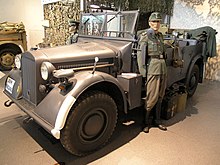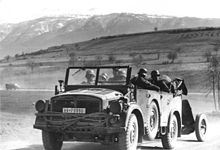Einheits-PKW der Wehrmacht
This article includes a improve this article by introducing more precise citations. (February 2021) ) |

Einheits-Pkw der Wehrmacht – literally: "standard passenger motor-car of the Wehrmacht" – was the
The whole program yielded only some 60,000
The new, standardized military vehicles were intended to replace the diverse fleet of two-wheel drive, militarized civilian vehicles previously procured by the Reichswehr – the Weimar Republic (1918–1933) predecessor of the Wehrmacht – with new cross-country mobile vehicles for military requirements in order to simplify logistics, maintenance and training by using standardized components.
The three main classes Leichter Einheits-Pkw, Mittlerer Einheits-Pkw, and Schwerer Einheits-Pkw (light, medium, and heavy standardized cars) were planned to use uniform chassis and mechanicals according to their weights and payloads, and each chassis would carry a number of different bodies for different purposes – similar to, but preceding the concepts of the U.S. made Dodge WC series, or the later High-Mobility, Multipurpose Wheeled Vehicles (HMMWV / Humvee). The lightest of the three classes was also intended to serve as the U.S. 1⁄4-ton jeeps did.
Because of the insufficiently developed German automotive industry at that time,
Development

Early on in the process of motorizing the German military before World War II, first the Reichswehr, and then the Wehrmacht had procured militarised versions of many different makes and models of civilian passenger cars. Therefore, the Wehrmacht's inventory of passenger cars was unsatisfactory in a number of respects when open
After the
- Leichter geländegängiger Personenkraftwagen (le. gl. Pkw) "light off-road passenger car"
- Mittelschwerer geländegängiger Personenkraftwagen (m. gl. Pkw) "medium off-road passenger car"
- Schwerer geländegängiger Personenkraftwagen (s. gl. Pkw), "heavy off-road passenger car)"
- Leichter geländegängiger Lastkraftwagen (le. gl. Lkw). "light off-road truck"
- Mittelschwerer geländegängiger Lastkraftwagen (m. gl. Lkw), "medium off-road truck"
Among other features, all types were required to have
The chassis of the heavy off-road passenger car was also used for the Leichter Panzerspähwagen (Sd.Kfz. 221 and Sd.Kfz. 222) armoured cars, although its engine was mounted in the rear.
The first light off-road passenger cars were delivered by Stoewer in 1936 (R 180 Spezial), followed in 1937 by the first medium and in 1938 by the first heavy models. The weaknesses of the programme quickly became obvious - high costs, complex production and overstrained manufacturers unable to supply sufficient numbers of vehicles to fill all the slots of the receiving military units as planned. The Wehrmacht therefore still had to source 60% of their requirements elsewhere - converting standard civilian cars to military use, euphemistically terming them Ergänzungsfahrzeuge ("supplementary vehicles"), as well as employing requisitioned and captured civilian cars. This in turn led to many disadvantages with maintenance, supply and training.
Enquiries with the different branches of the military revealed that the Einheits-Pkw were also flawed designs largely unfit for wartime service. Not even the simplifications implemented on bodies and chassis in 1940 (Typ 40), without the complex four-wheel steering among others, succeeded in remedying the multitude of shortcomings. Their complex designs and excessive wear and tear aside, all types were mainly criticised for their high weight, which in turn meant a high fuel consumption and led to many broken frames and suspensions in the field. Accordingly, production of the three types ceased in 1942, 1943, and 1941, respectively.
Types
Leichter geländegängiger Pkw

The light off-road passenger car was built by the BMW-Werk Eisenach under the designation BMW 325, as well as Hanomag (Typ 20 B) and Stoewer (Typ R 180 Spezial). The vehicles were used as troop carriers (Kfz. 1), by repair-and-maintenance squads (Kfz. 2/40), by artillery reconnaissance sonic measurement squads (Kfz. 3) and by troop-level aerial defence (Kfz. 4). Between 14.525[1] and 17.521 units[2] were built. Between 1940 and 1943, only Stoewer continued to build the R 200 Spezial without the four-wheel steering (Typ 40). The cars weighed 1,775 kg empty (1,700 kg without the four-wheel steering). 90% of all military branches rejected the vehicle as "unfit for wartime service" in a 1942 enquiry, while the much simpler, lighter and cheaper Volkswagen Kübelwagen proved to be far superior in basically every respect.
Mittelschwerer geländegängiger Pkw

The medium off-road (passenger) cars were mainly built by
The most conspicuous change of the 1940 design simplification was the elimination of the mid-mounted spare wheels which simplified the bodywork and gave more interior space. The cars had a Horch V8 (Opel: in-line 6-cylinder) and a curb weight of 2,700 kg (open-topped Horch version: 3,080 kg) and was the only type that did not even initially have four-wheel steering. 80% of military branches rejected the vehicle as unfit for wartime service.

Schwerer geländegängiger Pkw
The heavy off-road passenger car was built by Horch in Zwickau and Ford Germany in Cologne, each using their own V8 engines. They were used by the signals corps (Kfz. 23 and 24), as ambulances (Kfz. 31), as artillery tractors for light artillery (Kfz. 69) and anti-aircraft guns (Kfz. 81), as troop carriers (Kfz. 70) and as a carrier of AA searchlights (Kfz. 83). Furthermore, the armoured troop carrier Sd.Kfz. 247 and the rear-engined Leichter Panzerspähwagen armoured car in all its versions used the same chassis. Various versions of the Horch totaled 8,135 units, and 1,901 Ford models were built, for a total of just over 10,000 units.[7][8]
The cars had an empty weight of 3,300 kg[8] with four-wheel steering, and 3,200 kg without. Like the others, the heavy type lost the four-wheel steering along with the mid-mounted spare wheels in 1940. Although it suffered from the same deficiencies initially mentioned, as well as heavy steering, it appears to have been the most successful type of the standardised off-road passenger car programme.
Leichter geländegängiger LKW

Development of standardised trucks (Einheits-Lastkraftwagen) for the German military started in 1934. They originally wanted three standard chassis with two, three, and four driven axles, all with large, single wheels and off-road payload capacities of 1.5, 2.5 and four metric tons respectively.[9] Four prototype units of the four-axle, eight-wheel variant were built and later repurposed for special duty. In the end, only the three-axle, six-wheeled, 2.5 ton variant entered series production and was manufactured from 1937 through 1940. Its full official designation became: leichter geländegängiger Lastkraftwagen, offen (light cross-country lorry, open(-cab)). Commonly, they were often just called the "Einheitsdiesel" (standard diesels).
The Leichter geländegängiger Lastkraftwagen (abbreviated as "le. gl. Lkw"), for "Light off-road capable Lorry/truck", had large single wheels with off-road tyres and independent suspension all around.
Specifications
| Light (le. E. Pkw) | Medium (m. E. Pkw) | Heavy (s. E. Pkw) | Light standard truck (le. gl. Lkw) | |
|---|---|---|---|---|
| Manufacturers: | Stoewer, BMW, Hanomag | Auto Union, Opel | Auto Union, Ford | Borgward, Büssing-NAG, Daimler-Benz, Faun, Henschel, Krupp, Magirus, MAN, Vomag |
| Production period: | 1936 - 1942 | 1937 - 1943 | 1938 - 1941 | 1937 – 1940 |
| Length: | 390 cm (12 ft 10 in) | 470 cm (15 ft 5 in) | 484 cm (15 ft 11 in) | 585 cm (19 ft 2 in) [13] |
| Width: | 169 cm (5 ft 7 in) | 186 cm (6 ft 1 in) | 200 cm (6 ft 7 in) | 220 cm (7 ft 3 in) [13] |
| Height: | 190 cm (6 ft 3 in) | 207 cm (6 ft 9 in) | 204 cm (6 ft 8 in) | 240 cm (7 ft 10 in) [13] |
| Maximum weight: | 2.2t | 3.0t | 4.0t | 7.3t |
| Payload: | 500 kg (1,100 lb) | 600 kg (1,300 lb) (Funkwagen radio car: 980 kg (2,160 lb)) |
1,000 kg (2,200 lb) (Type 40 1,100 kg (2,400 lb)) |
2,500 kg (5,500 lb) |
| Ground clearance: | 23.5 cm (9.3 in) | 24 cm (9.4 in) | 25 cm (9.8 in) | – |
| Wheelbase: | 240 cm (94 in) | 300 cm (120 in) | 280 cm (110 in) | – |
| Track width: | 140 cm (55 in) | 140 cm (55 in) | 160 cm (63 in) | – |
| Engine: | Stoewer "AW 2" 4-cyl. petrol, 48–50 PS (47–49 hp) |
Horch "830" 3.5L 8-cyl. petrol 80 PS (79 hp) |
HWa* "526 D" 6.2L, 6-cyl. inline diesel, 80 PS (79 hp) developed by MAN, Henschel, and Humboldt-Deutz [13] HeeresWaffenamt
| |
| Alternative engine: | Stoewer "R 180W" 4-cyl. petrol 42–43 PS (41–42 hp) |
Horch V-8 3.8L 8-cyl. petrol 90 PS (89 hp) |
No alternate power-plants | |
| Alternative engine: | BMW-"325" 6-cyl. petrol 45 PS (44 hp) |
Opel R-6 3.6L 6-cyl. petrol 68 PS (67 hp) |
Ford V-8 3.6L 8-cyl. petrol 78 PS (77 hp) |
– |
| Alternative engine: | Hanomag "20 B" 6-cyl. petrol 48–50 PS (47–49 hp) |
- | - | |
| Top speed: | - | - | - | 70 km/h (43 mph) |
| Range: | 400 km (250 mi) | 400 km (250 mi) | - | 290 km (180 mi) cross-country / 360 km (220 mi) on-road |
See also
- High-Mobility Multipurpose Wheeled Vehicle
- Military light utility vehicle
- GAZ-61 – early Russian 4x4 staff sedan (1938–1945)
- GAZ-64 / GAZ-67 – Russian WWII jeep equivalents
- Kurogane Type 95 – Japanese light scout car (1936–1944)
- U.S. World War II 1/4-ton jeeps (Ford & Willys; 1941–1945)
- Dodge VC- and VF-series 1/2-ton and 1½-ton vehicles (1940)
- Dodge WC series 1/2-ton, 3/4-ton and 1½-ton vehicles (1941–1945)
- Volkswagen Kübelwagen – succeeded light / medium Einheits-Pkw (1940–1945)
- U.S. standard WW II, 2½-ton, 6×6 truck
Inline notes
This section needs expansion. You can help by adding to it. (July 2021) |
- ^ Quartermaster Section (2021), Leichter Geländegängiger PKW.
- ^ KFZderWehrmacht (2018), Leichter Einheits-Pkw.
- ^ Vollert, Jochen. (2017) Einheits-Pkw leicht-mittel-schwer, Tankograd – Wehrmacht Special No 4021, Jochen Vollert—Tankograd Publishing, Erlangen. Page 27.
- ^ (about 10,000 with Horch engines, and the remaining 6,000 with Opel motors)
- ^ Opel's production figures have been lost in the war.
- ^ KFZderWehrmacht (2018), Mittlerer Einheits-Pkw.
- ^ KfzderWehrmacht (2018), Schwerer Einheits-Pkw.
- ^ a b Quartermaster Section (2021), Schwerer Einheits-Pkw.
- ^ KFZderWehrmacht (2018), Leichter geländeg. LKW / “Einheitsdiesel”.
- ^ a b Einheitsdiesel (in Dutch) – Overloon War Museum
- ^ a b c KFZderWehrmacht (2018), Leichter geländeg. Lastkraftwagen “Einheitsdiesel”.
- ^ Einheits-Diesel, l. gl. E.Lkw 6x6 Typ HWA 526 D - Light Off-road-capable Standarised Truck (Tankograd Wehrmacht Special No. 4017) – Christian Schmidt Books
- ^ a b c d e Leichter geländegängiger Lastkraftwagen – Pantser.net (in Dutch)
References
- Steve Zaloga; et al. (2021). "Welcome to the Quartermaster Section". Quartermaster Section.
- Erdmann, Holger (15 August 2018). "Welcome to "Kfz. of the Wehrmacht"". Kfz der Wehrmacht (in English and German). Translated by Erdmann; Henss, Mareike.
- Oswald, Werner: Kraftfahrzeuge und Panzer der Reichswehr, Wehrmacht und Bundeswehr. Motorbuch Verlag, Stuttgart, 17. Auflage 2004, ISBN 3-613-02370-9
- Spielberger J., Walter: Armored Vehicles of the German Army 1905–1945 (The Spielberger German Armour and Military Vehicle Series)
- Vorschrift D 662/4 Einheitsfahrgestell I für leichten Personenkraftwagen Typ 40, Gerätebeschreibung und Bedienungsanweisung, Berlin 1941
